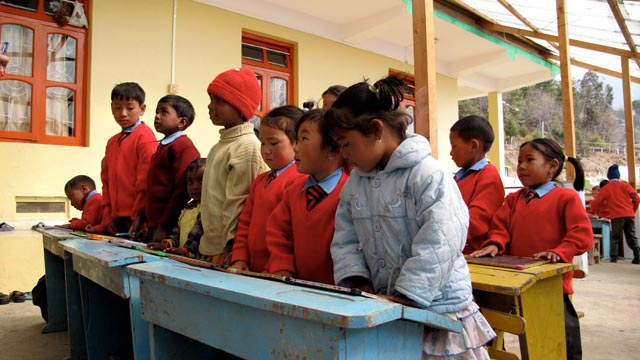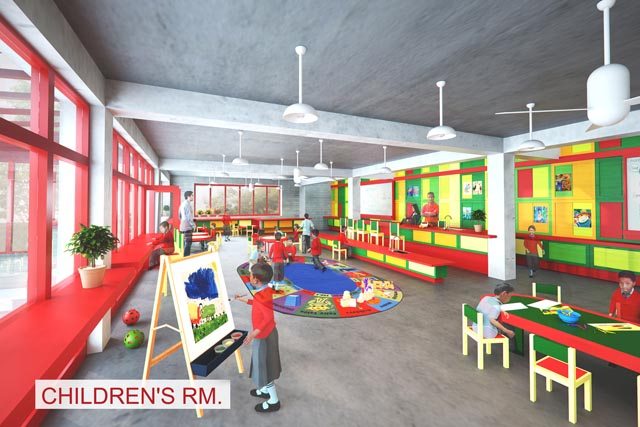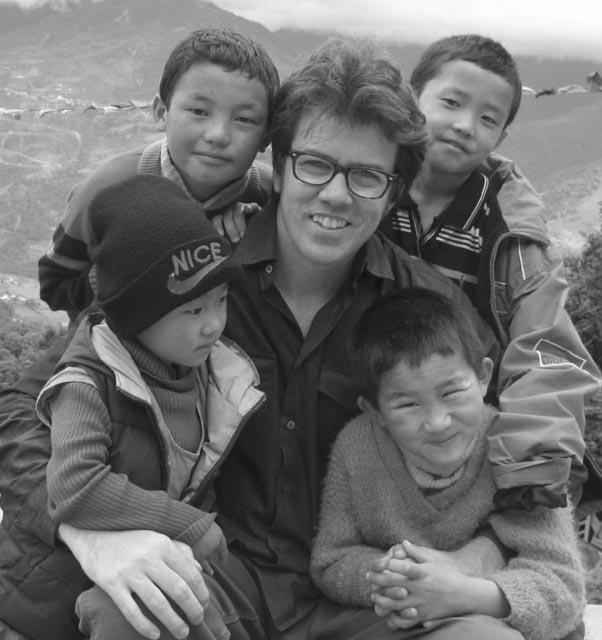
If you’ve ever wondered how the Internet can change lives, you have only to hear the story of John Ullman, an architectural designer in Brooklyn, NY. Since doing community service was a requirement for obtaining his American architectural license, he keyed in two words into the Google search bar: ‘India’ and ‘volunteer.’
The name of Manjushree Orphanage in Tawang, Arunachal Pradesh came up, and now three years later, this is where Ullman’s destiny lies and where he is building a brand new school for the children of this village. Currently the school is rundown and with no heat, even in the dead of winter. The images of the planned school look like something out of a dream, a gift which will make learning an adventure for these children who have little.
Ullman’s own adventure in Tawang began in 2007 when he went to India for the first time and visited the Manjushree Orphanage which is run by a Tibetan Buddhist Lama, Thupten Phunsok. The region is home to the Monpa, tribal people of Buddhist faith. The school houses 150 orphans, eleven of whom are physically disabled, and also educates 37 students from nearby villages.
Volunteering his skills and time, Ullman taught the older students basic engineering. He recalls, “I was captivated by this pristine land, and admired the generous, warmhearted nature of its people. But I was also struck by the poverty that they faced, and wanted to help.”
This bleak, mountainous area in the Himalayas is one to which progress and innovation has come slowly – some decades back these villages had no electricity, roads or schools. It is an area where survival is a challenge. The mission of the school is to provide a caring home environment to orphans, physically disabled or destitute children, and to give them a modern education as well as teach them values of compassion. Says Ullman: “My big wish is for these good Himalayan people to live happier, healthier lives through the low cost, high quality buildings we are planning.”

He has founded Architecture for Tibet , a non-profit organization, and the first project it’s undertaken is an academic center for the Manjushree Orphanage to replace the crumbling school which the children currently attend in this area of harsh winters and heavy summer rains.
The proposed two-story building contains classrooms, a library, a multi-purpose space, a computer and language lab, and a large nursery for the younger children. Temperatures will be regulated through a combination of geothermal and solar-based technologies which are being used for the first time in this region. An innovative highlight is three Sun Spaces which will serve as open-air teaching rooms during the summer, as a sheltered space for the children to stay active during the long rainy season and a warm, cozy place during the winter.
In order to raise funds for the project, a benefit fundraiser is being held at Rubin Museum of Art on May 25. Dr. Robert Thurman, noted Buddhist scholar, Lobsang Nyandak, Representative to His Holiness the Dalai Lama and Dr. Tatsumura Hillyer of Tibet House will be some of the speakers.
Asked if he himself is a Buddhist or believes in Buddhist philosophy, Ullman says, “I am not a Buddhist but I believe that when we are generous and compassionate towards others, we can find the greatest treasure of all: a mind and heart of pure motivation, from which to see the world most clearly – kind of like the Buddhist view that I admire so much.”
What kind of satisfaction does he get from doing this work in a forgotten, isolated corner of the world rather than gearing up for building skyscrapers in the glittering metropolis of New York?
“Pursuing a typical career path, which often causes stress, is not always the ticket to a happy life,” he says. “I think I am blessed to have stumbled upon the Orphanage, as it has gifted me with the opportunity to cultivate a pure mind and heart, which is my great treasure.
Architecture is my tool for shaping places of wonder and humanity. To be able to offer my services is a privilege, as I am afforded the opportunity of making a contribution towards positive human experience and development, which in turn helps me have a happy life. I am very glad to serve these precious children.”

Uniting the Moon with the Sun
“I sponsor a 7 year old boy named Nima, who is nicknamed ‘My little Buddha,’ as he looks just like Shakyamuni Buddha, the Buddha of our time. I learned of Nima being separated from his twin Dawa when he arrived at Manjushree, and felt compelled to reunite them. (Nima translates as sun; Dawa, as moon.)
Nima was 5 years old when he was admitted to Manjushree Orphanage. His parents divorced and left Nima as well as Dawa, his twin, to be raised by their grandmother. Due to her poverty, she requested that the orphanage accept one of the boys, and Nima ended up there.
As I was moved to reunite them, I drove out to Nima’s remote village with the boy and Gopal, his math teacher at Manjushree. His grandmother was not home. Nima then brought us to the place where she worked breaking stones (it’s common in the region for elderly women to break rocks into gravel to be used for concrete, which is then sold for about $1 per 100-pound bag).
She was a bit startled at the sight of Nima – and us. We explained that we hoped to take Dawa to Manjushree. She was very pleased, as she didn’t know what to do with Dawa; she wasn’t able to provide for him and was considering sending him off to one of the local monasteries. I saw a kind of palpable happiness come over her. Dawa was called in from the rolling fields, where he had been playing alone around a horse stable.
Now they are at Manjushree and I am so happy that they are together. The moon – I like to think – was reunited with the sun.”
– John Ullman, describing his special bond to the children of Manjushree.
DESIGNING GREEN AND SOLAR
Q: Structures for the poor are usually badly designed. As an architect, how do you think good design enhances the daily life of these students?
A: The planned spaces of the new academic center are the fruit of a dialog with the teachers and Lama Thupten, the founder of Manjushree Orphanage and Free School. I asked them “is this a place you want to be.” Then I listened; truly listened. Architects start the planning process with someone’s wishes and needs in mind.
In the case of the new center one of the needs is for the children to have larger classrooms; the wish, then, is for these spaces to be warm in the winter, cool in the summer, have an abundance of natural light, to catch the breeze, and of course, to be a place that the children and teachers want to spend their time all day long, and all throughout the seasons. Therefore, it is very important also for the building spaces to be flexible, to serve two, or three programmatic uses: a class room is also sometimes a room for tutoring, and sometimes a room for hobbies for example. So I imagine these children in their “world.”
The requisite needs for providing educational environment must of course be met, but these spaces must also bring about a sense of dignity and hope. And so the architect must see the merit of offering his unabashed creativity and compassion towards others before himself – and before his practical knowledge of construction -for the building to be architecture.
Q. Is it not heated at all right now and what kind of heat are you planning to use?
There is presently no means of heating building spaces at the Orphanage. The new academic center is designed with a geothermal heating system for radiant flooring, which will be of great value in this cold and damp Himalayan locale. This “Green” technology will be the first of its kind in the region. AFT is working in collaboration with Solar India Solutions to implement this hi-tech yet practical building feature. The building will also feature passive solar sun-spaces, for a supplemental heat source while also flooding the building with natural light.
Q: Where do the plans stand currently and who else do you have on board?
The building is ready to break ground in early summer of this year. Evan Akselrad, our structural engineering consultant here in New York, has been a tremendous help during the development of the earthquake resistant design system, and Chandra Shekar – who is based in Visakhapatnam, Andhra Pradesh – and I have been in collaboration on the mechanical aspects of the project. Many other construction professionals have contributed their talents along the way including Stan Slutsky, plumbing and mechanical systems consultant; Alex Roden, electrical; and Brent Porter, sun analysis.
